Introduction
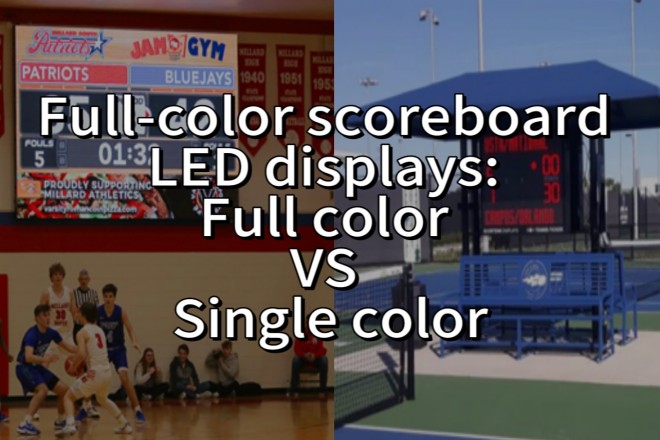
In sports stadiums, LED score screens are an important bridge between events and spectators. Faced with the choice of full-color and single color LED display screens, each decision affects the audience’s viewing experience and the economic benefits of the venue.
This article will take you to an in-depth understanding of the characteristics of these two displays, helping you make a wise choice between the dazzling full-color and the economic single color.
1. Analysis of the advantages and disadvantages of full-color scoring LED display screen
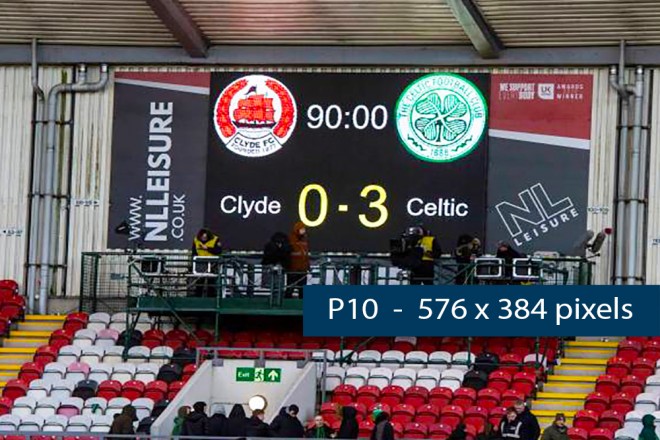
In modern stadiums, full-color score LED display screens have become an indispensable and important facility.
It displays game scores, statistics and highlights in real time, bringing a more immersive viewing experience to the audience. However, this high-tech product also comes with some specific advantages and disadvantages.
1). Advantages:
- Bright colors and intuitive information:
The full-color score LED display screen presents colorful images and clear text information through the combination of red, green, and blue primary colors. In the game, this makes key information, such as scores, time, player data, etc., clear at a glance, allowing the audience to quickly and accurately grasp the dynamics of the game.
- Seamless splicing, shocking effect:
In large stadiums, multiple full-color scoring LED screens can be seamlessly spliced to form an ultra-large area and high-resolution display area. This not only enhances the visual effect but also can display wonderful replays, tactical analysis, etc., at critical moments, bringing a more shocking viewing experience to the audience.
- High brightness and waterproof, strong adaptability:
The stadium environment is changeable, and the high brightness and waterproof design of the full-color scoring LED display enable it to cope with various severe weather conditions.
Whether it is a sunny day or a rainy night, it can maintain a clear display effect to ensure the accurate transmission of game information.
- Wide viewing angle, covering the whole field:
The full-color scoring LED display has a wide viewing angle range, and no matter where the audience sits, they can clearly see the content on the display. This ensures the fairness of the game and the transparency of information, allowing the audience to enjoy the game more devotedly.
2). Disadvantages:
- Power consumption and maintenance cost:
Although LED technology is relatively mature, the large-scale use of full-color scoring LED displays still brings greater energy consumption.
In addition, regular maintenance and cleaning are also essential, including checking whether the lamp beads are damaged and cleaning the display surface, which all require a certain amount of cost investment.
- Complex installation and maintenance:
The installation and maintenance of the full-color scoring LED display requires professional technology and a team.
In complex environments such as stadiums, wiring, and fixing issues also need to be considered. Once a fault occurs, it is necessary to respond quickly and carry out professional repairs to ensure the smooth progress of the game.
- Sensitive to environmental factors:
The stadium environment is complex and changeable, and the full-color scoring LED display may be affected by environmental factors such as light reflection, high temperature, and humidity.
This may lead to a decrease in display effect or accelerated aging of the lamp beads, and corresponding protective measures need to be taken to extend the service life of the display.
2. Analysis of the advantages and disadvantages of single color scoring LED display
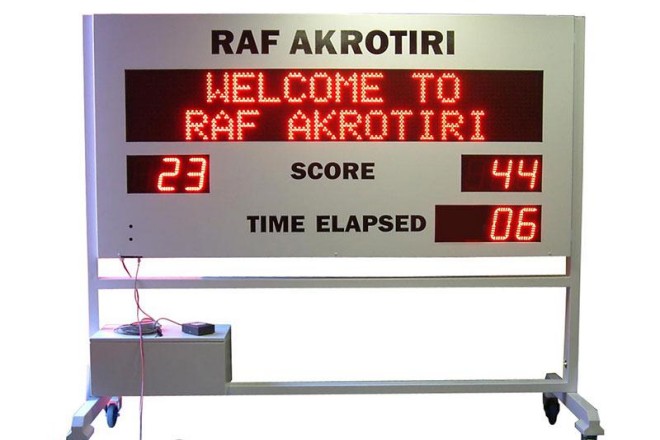
Single color scoring LED display, as a common form of stadium score screen, has its unique advantages and disadvantages.
The following is a detailed analysis of the advantages and disadvantages of single color scoring LED displays in stadium applications:
2.1). Advantages:
- The visual is simple and clear, and the information is conveyed intuitively:
In occasions such as stadiums where game information needs to be obtained quickly and accurately, the simple design of the single color scoring LED display makes the text and numbers clearer and easier to read.
It avoids the visual interference caused by color, allowing the audience to quickly capture key information such as scores and time, ensuring the smooth progress of the game.
- Low cost and economical:
Compared with full-color LED displays, single color displays have lower manufacturing costs, which makes it have a great advantage in price. For stadiums or event organizers with limited budgets, single color displays are an economical choice.
At the same time, lower maintenance costs also reduce the economic pressure of long-term operations.
- Energy saving and power saving, green and environmentally friendly:
single color displays perform well in energy consumption because they only use LED lamp beads of one color, and the energy consumption is much lower than that of full-color displays.
In occasions such as stadiums where scoreboards need to run for a long time, single color displays can significantly reduce energy consumption and reduce energy waste, which is in line with the environmental protection concept of modern society.
- Strong adaptability and wide application:
single color LED displays have strong adaptability and can be used in various occasions where simple information needs to be displayed.
In the stadium, it can not only withstand harsh weather conditions, but also maintain clear display effects in various light environments. This makes single color displays an ideal choice for stadium scoreboards.
- Convenient installation and maintenance, reducing operating costs:
The installation process of single color displays is relatively simple and does not require complicated wiring or debugging work.
This reduces installation time and cost, allowing the stadium to be put into use more quickly. At the same time, due to the simple structure, it is also easier to repair, reducing maintenance costs during operation.
2.2). Disadvantages:
- Single color, limited visual effects:
The biggest disadvantage of single color display is that it has a single color and cannot present rich color effects.
In occasions such as stadiums that need to create an atmosphere and attract spectators, single color displays may appear monotonous and boring in visual effects. Compared with full-color displays, it may not bring a more shocking viewing experience to the audience.
- Limited application scenarios and inability to meet specific needs:
Due to the limitation of a single color, single color displays may not meet requirements under certain specific needs.
For example, on occasions where team logos, advertising images, or exciting moments need to be displayed, single color displays may seem powerless. This limits its application scope in certain high-end events or commercial activities.
- Slow technology update speed:
Compared with full-color LED displays, the technology update speed of single color displays is relatively slow. This is mainly because the market demand for single color displays is relatively stable, and there is a lack of technological innovation and competitive pressure like full-color displays.
Therefore, the improvement of single color displays in technology and performance may not be as significant as full-color displays. However, this does not mean that there is no room for the development of single color displays. As technology continues to advance, single color displays may also be further improved in performance.
3. Analyze which of the two LED scoreboards is better based on applicable scenarios
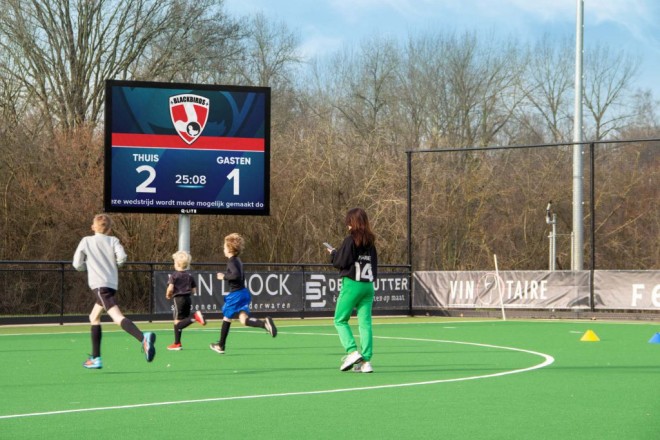
In the process of purchasing a stadium scoreboard, the choice between single color LED and full-color LED is a crucial decision.
The following is a detailed comparative analysis of the two scoreboards, which aims to help stadium managers or event organizers understand their characteristics more comprehensively and make a more informed choice.
1). Visual effects and game atmosphere creation
1.1). single color LED scoreboard:
- Simple and clear:
The single color LED scoreboard can clearly convey key information such as score and time with its simple design style. This design is not only easy for the audience to read but also maintains the readability of information in strong light or outdoor environments.
- Single color:
Although the color of the single color LED scoreboard is relatively single, this also makes it an advantage on some occasions. For example, in occasions where the game itself needs to be emphasized rather than other visual elements, the single color scoreboard can avoid distracting the audience’s attention.
- Applicable scenarios:
single color LED scoreboards are suitable for small and medium-sized stadiums, grassroots events, or training venues, as well as those occasions that do not require high color reproduction but pursue economy and stability.
1.2). Full-color LED scoreboard:
- Rich visual effects:
Full-color LED scoreboards can present colorful images, videos, and animation effects, greatly enhancing the visual experience of the game. This rich visual effect not only attracts the audience’s attention but also adds fun and interactivity to the game.
- Enhance the atmosphere of the game:
By displaying team logos, advertisements, or highlights, full-color LED scoreboards can create a more enthusiastic game atmosphere and enhance the audience’s sense of participation and belonging.
- Applicable scenarios:
Full-color LED scoreboards are suitable for large stadiums, commercial events, or international events, as well as those that pursue high-end visual effects and audience experience.
2). Cost-effectiveness and budget considerations
2.1). single color LED scoreboard:
- Low production cost:
The production cost of single color LED scoreboards is relatively low, mainly due to its simple circuit structure and single color requirements. This makes it have a greater advantage in price and is suitable for stadiums or events with limited budgets.
- Low maintenance cost:
The single color LED scoreboard has a simple structure and is more convenient to repair. This reduces the difficulty and cost of maintenance during operation, allowing stadium managers to focus more on the game itself.
- Long-term operation:
In the long run, the energy consumption of single color LED scoreboards is also low, which helps to reduce operating costs. This is an advantage that cannot be ignored for stadiums that need long-term operation.
2.2). Full-color LED scoreboard:
- High production cost:
The production cost of full-color LED scoreboards is high, mainly because it requires complex color mixing technology and high-quality LED lamp beads. This makes it relatively expensive in price, but it can bring greater commercial value and audience appeal.
- High maintenance cost:
Full-color LED scoreboards require regular inspection and replacement of faulty lamp beads to ensure the clarity of the picture and the accuracy of color. This increases the maintenance cost and technical difficulty during operation.
- Return on investment:
Although the initial investment of full-color LED scoreboards is high, in the long run, it can bring more business opportunities and revenue to the stadium by improving the atmosphere of the game and the audience experience. Therefore, when considering the return on investment, multiple factors need to be considered comprehensively.
3). Technical characteristics and stability
3.1). single color LED scoreboard:
- Mature technology:
The technology of single color LED scoreboards is relatively mature and stable, with a low failure rate. This makes it more reliable during operation and reduces the risk of game interruptions or delays due to technical failures.
- Brightness adjustment:
The brightness of the single color LED scoreboard can be adjusted as needed to adapt to different light environments. This ensures that the audience can clearly see the information on the scoreboard in different time periods and weather conditions.
- Easy to install:
The installation process of the single color LED scoreboard is relatively simple and does not require too much technical support. This allows stadium managers to deploy the scoreboard faster and prepare for the game.
3.2). Full-color LED scoreboard:
- Technical innovation:
The full-color LED scoreboard requires precise color control technology to achieve color mixing and gradient effects. This requires manufacturers to have a high level of technology and innovation capabilities.
At the same time, in order to ensure the clarity of the picture and the accuracy of the color, the full-color LED scoreboard also needs to have the characteristics of brightness and color uniformity.
- Technical challenges:
There are certain technical challenges in the full-color LED scoreboard. For example, how to ensure the consistency of the luminous efficiency and life of LED lamp beads of different colors? How to avoid color distortion or uneven brightness?
These all require manufacturers to conduct in-depth research and development and optimization.
- Professional maintenance:
Full-color LED scoreboards require professional technical support and maintenance teams to ensure their normal operation.
This includes regular inspection and replacement of faulty lamp beads, adjustment of brightness and color, etc. This increases the technical difficulty and cost during operation.
4). Applicable scenarios and maintenance operations
4.1). single color LED scoreboard:
- Applicable scenarios:
single color LED scoreboards are suitable for those occasions that do not require high color reproduction but pursue economy and stability. For example, small and medium-sized stadiums, grassroots events or training venues.
On these occasions, the single color scoreboard can clearly convey score information and meet the basic needs of the audience.
- Maintenance and operation:
The maintenance and operation of single color LED scoreboards are relatively simple. Due to the simple structure and easy maintenance, stadium managers can focus more on the game itself without paying too much attention to the maintenance of the scoreboard.
This reduces the difficulty and cost of management, allowing the stadium to operate more efficiently.
4.2). Full-color LED scoreboard:
- Applicable scenarios:
Full-color LED scoreboards are suitable for those occasions that need to display colorful images, videos, or animation effects. For example, large stadiums, commercial events, or international events.
On these occasions, the full-color scoreboard can create a more enthusiastic game atmosphere and enhance the audience’s sense of participation and belonging.
- Maintenance and operation:
The maintenance and operation of the full-color LED scoreboard is relatively complex. Since it is necessary to regularly check and replace faulty lamp beads, adjust brightness and color, etc., the stadium manager needs to have certain technical support and maintenance capabilities.
At the same time, in order to ensure the normal operation of the scoreboard and the audience’s viewing experience, regular cleaning and maintenance work is also required. This increases the technical difficulty and cost in the operation process, but it can also bring greater commercial value and audience appeal.
4. Analyze which of the two LED scoreboards is better based on the budget
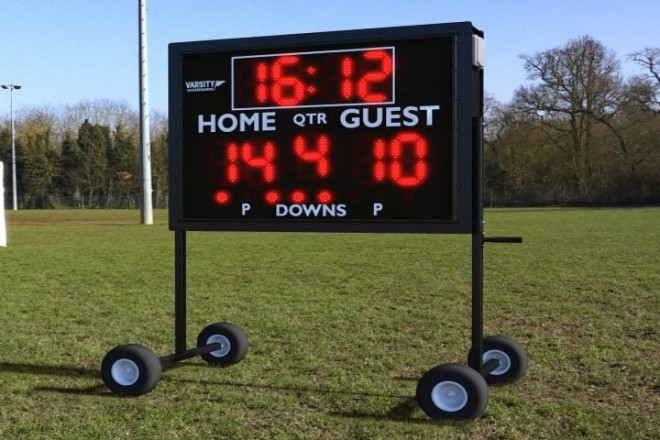
When evaluating which is more suitable, the single color LED scoreboard or the full-color LED scoreboard, based on the budget, we can conduct in-depth analysis from multiple dimensions to ensure that every penny is spent on the blade.
1). Budget considerations:
1.1). When the budget is tight: The advantages of the single color LED scoreboard
Cost-effectiveness: The single color LED scoreboard is usually more affordable due to its simple structure and low technical threshold. For customers with limited budgets, it is a very cost-effective choice.
Easy maintenance: The maintenance cost of a single color LED scoreboard is relatively low because it has fewer parts, is relatively easy to repair, and is not prone to failure.
Long life: Single color LEDs generally have a longer lifespan and can operate stably for a long time, reducing the need for frequent replacement of parts.
1.12). When the budget is sufficient: The charm of a full-color LED scoreboard
Visual feast: Full-color LED scoreboards are known for their colorful and vivid images, which can greatly enhance the audience’s visual experience and are the best choice for attracting attention and enhancing brand image.
Wide application: Full-color LED scoreboards are not only suitable for displaying scores of sports events, but can also be widely used in commercial advertising, cultural performances, exhibitions and other occasions.
Brand promotion: High-quality full-color LED scoreboards can not only display high-quality visual content but also reflect the professionalism and brand image of the company, bringing potential commercial value to the company.
2). Usage requirements:
single colorLED scoreboards: Suitable for occasions that do not require high color and focus on practicality and economy, such as schools, small gyms, etc.
Full-color LED scoreboard:
Suitable for occasions that need to display complex images, videos, or animation effects and have high visual effects requirements, such as large stadiums, shopping malls, concerts, etc.
3). Maintenance and operation:
single colorLED scoreboard: Low maintenance cost, low requirements for the technical team, suitable for long-term stable operation, reducing unnecessary maintenance expenses.
Full-color LED scoreboard: Although the initial investment and maintenance costs are high, through fine management and regular maintenance, the service life can be extended, and the cost performance can be improved.
4). Comprehensive suggestions
When deciding which LED scoreboard to choose, you should not only consider the current budget but also consider the use requirements, long-term operating costs, and expected visual effects. If the budget is limited and the color requirements are not high, the single color LED scoreboard is an economical and practical choice.
If the budget is sufficient and the visual shock and brand image are sought, the full-color LED scoreboard is a more appropriate choice.
In the end, the choice of which LED scoreboard requires you to weigh it according to your actual situation to ensure that every penny invested can bring the greatest value and benefits.
Conclusion
We have discussed the advantages and limitations of full-color and single color LED displays. The final choice should be based on the characteristics of your venue, budget considerations, and audience expectations.
I hope this article can provide you with valuable references to help you choose the most suitable LED scoreboard for your stadium and improve the viewing value of the event with the best cost-effectiveness.
Finally, if you want to know more about LED displays, please get in touch with us.
